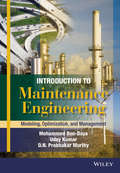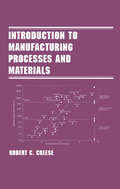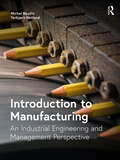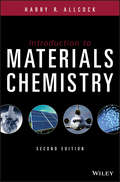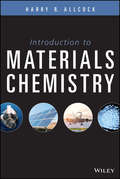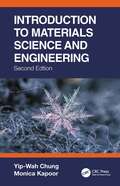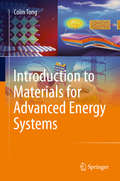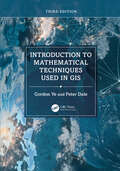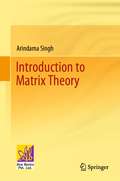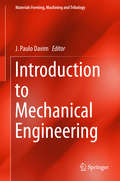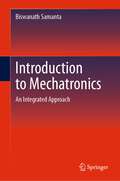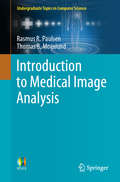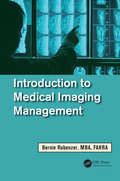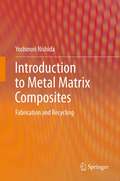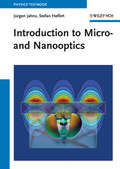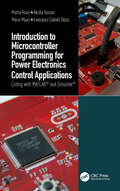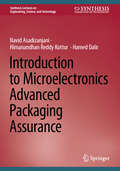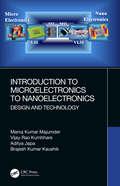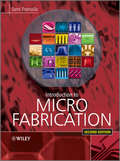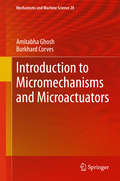- Table View
- List View
Introduction to Maintenance Engineering: Modelling, Optimization and Management
by D. N. Murthy Mohamed Ben-Daya Uday KumarThis introductory textbook links theory with practice using real illustrative cases involving products, plants and infrastructures and exposes the student to the evolutionary trends in maintenance. Provides an interdisciplinary approach which links, engineering, science, technology, mathematical modelling, data collection and analysis, economics and management Blends theory with practice illustrated through examples relating to products, plants and infrastructures Focuses on concepts, tools and techniques Identifies the special management requirements of various engineered objects (products, plants, and infrastructures)
Introduction to Manufacturing Processes and Materials (Manufacturing Engineering and Materials Processing #Vol. 54)
by Robert CreeseThe first manufacturing book to examine time-based break-even analysis, this landmark reference/text applies cost analysis to a variety of industrial processes, employing a new, problem-based approach to manufacturing procedures, materials, and management. An Introduction to Manufacturing Processes and Materials integrates analysis of material costs and process costs, yielding a realistic, effective approach to planning and executing efficient manufacturing schemes. It discusses tool engineering, particularly in terms of cost for press work, forming dies, and casting patterns, process parameters such as gating and riser design for casting, feeds, and more.
Introduction to Manufacturing: An Industrial Engineering and Management Perspective
by Michel Baudin Torbjørn NetlandThis Introduction to Manufacturing focuses students on the issues that matter to practicing industrial engineers and managers. It offers a systems perspective on designing, managing, and improving manufacturing operations. On each topic, it covers the key issues, with pointers on where to dig deeper. Unlike the many textbooks on operations management, supply chain management, and process technology, this book weaves together these threads as they interact in manufacturing. It has five parts: Getting to Know Manufacturing: Fundamental concepts of manufacturing as an economic activity, from manufacturing strategy to forecasting market demand Engineering the Factory: Physical design of factories and processes, the necessary infrastructure and technology for manufacturing Making Information Flow: The "central nervous system" that triggers and responds to events occurring in production Making Materials Flow: The logistics of manufacturing, from materials handling inside the factory via warehousing to supply chain management Enhancing Performance: Managing manufacturing performance and methods to maintain and improve it, both in times of normal operations and emergencies Supported with rich illustrations and teaching aids, Introduction to Manufacturing is essential reading for industrial engineering and management students – of all ages and backgrounds – engaged in the vital task of making the things we all use.
Introduction to Materials Chemistry
by Harry R. AllcockThis textbook introduces the reader to the elementary chemistry on which materials science depends by discussing the different classes of materials and their applications. It shows the reader how different types of materials are produced, why they possess specific properties, and how they are used in technology. Each chapter contains study questions to enable discussions and consolidation of the acquired knowledge. The new edition of this textbook is completely revised and updated to reflect the significant expansion of the field of materials chemistry over the last years, covering now also topics such as graphene, nanotubes, light emitting diodes, extreme photolithography, biomedical materials, and metal organic frameworks. From the reviews of the first edition: "This book is not only informative and comprehensive for a novice reader, but also a valuable resource for a scientist and/or an industrialist for new and novel challenges." (Materials and Manufacturing Process, June 2009) "Allcock provides a clear path by first describing basic chemical principles, then distinguishing between the various major materials groups, and finally enriching the student by offering a variety of special examples." (CHOICE, April 2009) "Proceeding logically from the basics to materials in advanced technology, it covers the fundamentals of materials chemistry, including principles of materials synthesis and materials characterization methods." (Internationale Fachzeitschrift Metall, January 2009)
Introduction to Materials Chemistry
by Harry R. AllcockIntroduction to Materials Chemistry will appeal to advanced undergraduates and graduate students in chemistry, materials science,and chemical engineering by leading them stepwise from the elementary chemistry on which materials science depends, through a discussion of the different classes of materials, and ending with a description of how materials are used in devices and general technology.
Introduction to Materials Science and Engineering
by Yip-Wah Chung Monica KapoorOur civilization owes its most significant milestones to our use of materials. Metals gave us better agriculture and eventually the industrial revolution, silicon gave us the digital revolution, and we’re just beginning to see what nanomaterials yield. Updated to reflect the many societal and technological changes in the field since publication of the first edition, Introduction to Materials Science and Engineering, Second Edition, offers an interdisciplinary view that emphasizes the importance of materials to engineering applications and builds the basis needed to select, modify, and create materials to meet specific criteria. The most outstanding feature of this book is the authors’ unique and engaging application-oriented approach. By beginning each chapter with a real-life example, an experiment, or interesting facts, the authors wield an expertly crafted treatment that entertains and motivates as much as informs and educates. The discipline is linked to modern developments, such as semiconductor devices, nanomaterials, and thin films, while working systematically from atomic bonding and analytical methods to crystalline, electronic, mechanical, and magnetic properties as well as ceramics, polymers, corrosion, and phase diagrams. Updates in the Second Edition References to advances in the field, including computational thermodynamics, allowing computation of phase diagrams with great accuracy and new materials Updated applications and technologies, such as electric vehicles and the use of magnetic fields as a processing tool Revised, practical end-of-chapter problems that go beyond traditional plug-and-chug exercises to enhance learning More examples with detailed solutions in each chapter A new chapter highlighting how materials can impact four United Nations Sustainable Development Goals This book is written for undergraduate students and readers interested in introductory materials science and engineering concepts. This concise textbook provides a strong foundation in materials science engineering and its applications. A solutions manual and PowerPoint lecture slides are available for adopting professors.
Introduction to Materials for Advanced Energy Systems
by Colin TongThis first of its kind text enables today’s students to understand current and future energy challenges, to acquire skills for selecting and using materials and manufacturing processes in the design of energy systems, and to develop a cross-functional approach to materials, mechanics, electronics and processes of energy production. While taking economic and regulatory aspects into account, this textbook provides a comprehensive introduction to the range of materials used for advanced energy systems, including fossil, nuclear, solar, bio, wind, geothermal, ocean and hydropower, hydrogen, and nuclear, as well as thermal energy storage and electrochemical storage in fuel cells. A separate chapter is devoted to emerging energy harvesting systems. Integrated coverage includes the application of scientific and engineering principles to materials that enable different types of energy systems. Properties, performance, modeling, fabrication, characterization and application of structural, functional and hybrid materials are described for each energy system. Readers will appreciate the complex relationships among materials selection, optimizing design, and component operating conditions in each energy system. Research and development trends of novel emerging materials for future hybrid energy systems are also considered. Each chapter is basically a self-contained unit, easily enabling instructors to adapt the book for coursework. This textbook is suitable for students in science and engineering who seek to obtain a comprehensive understanding of different energy processes, and how materials enable energy harvesting, conversion, and storage. In setting forth the latest advances and new frontiers of research, the text also serves as a comprehensive reference on energy materials for experienced materials scientists, engineers, and physicists. Includes pedagogical features such as in-depth side bars, worked-out and end-of- chapter exercises, and many references to further reading Provides comprehensive coverage of materials-based solutions for major and emerging energy systems Brings together diverse subject matter by integrating theory with engaging insights
Introduction to Mathematical Fire Modeling
by Marc L. JanssensComputer simulation proves to be a valuable tool for the analysis and prediction of compartment fires. With the proper understanding and software, fire safety professionals can use modeling tools and methods to find answers to many critical questions relating to the prevention, investigation, and reconstruction of compartment fires.Thorough
Introduction to Mathematical Techniques Used in GIS
by Peter Dale Gordon YeGIS technology and applications have advanced as fast as computing technology to enhance business analytics, predictive modeling, virtual reality, and artificial intelligence. The third edition addresses these new topics of interest to students and practitioners who are using geographic information systems but have a limited mathematical background. Thoroughly updated and reorganized to focus more on applications and problem solving by mathematical techniques, this book explains the basic architecture of computing as it relates to GIS, includes new application examples of selected mathematical methods, and introduces 3D modeling, machine learning, and more.Features Explains the basic mathematics that underpins the manipulation of spatially related data and adds new technology direction such as machine learning. Builds logically step-by-step from simple basic assumptions to real world GIS applications to illustrate mathematical techniques covered in each chapter. Explains computing fundamentals including databases, and modeling techniques such as network modeling and topology overlay. Includes two new chapters focused on how computing relates to mathematics, and new popular applications of GIS which connect with data science and artificial intelligence. Prepares today’s GIS students who do not have STEM backgrounds to follow the thought processes behind the practice of GIS. This textbook is written for those who use global information systems and applications but have a limited mathematical background. It explains the mathematics behind the applications, making it an accessible book for both undergraduate and graduate students in GIS, Computer Science, Geography, and Geomatics.
Introduction to Matrix Theory
by Arindama SinghThis book is designed to serve as a textbook for courses offered to undergraduate and postgraduate students enrolled in Mathematics. Using elementary row operations and Gram-Schmidt orthogonalization as basic tools the text develops characterization of equivalence and similarity, and various factorizations such as rank factorization, OR-factorization, Schurtriangularization, Diagonalization of normal matrices, Jordan decomposition, singular value decomposition, and polar decomposition. Along with Gauss-Jordan elimination for linear systems, it also discusses best approximations and least-squares solutions. The book includes norms on matrices as a means to deal with iterative solutions of linear systems and exponential of a matrix. The topics in the book are dealt with in a lively manner. Each section of the book has exercises to reinforce the concepts, and problems have been added at the end of each chapter. Most of these problems are theoretical, and they do not fit into the running text linearly. The detailed coverage and pedagogical tools make this an ideal textbook for students and researchers enrolled in senior undergraduate and beginning postgraduate mathematics courses.
Introduction to Mechanical Engineering (Materials Forming, Machining and Tribology)
by J. Paulo DavimThis textbook fosters information exchange and discussion on all aspects of introductory matters of modern mechanical engineering from a number of perspectives including: mechanical engineering as a profession, materials and manufacturing processes, machining and machine tools, tribology and surface engineering, solid mechanics, applied and computational mechanics, mechanical design, mechatronics and robotics, fluid mechanics and heat transfer, renewable energies, biomechanics, nanoengineering and nanomechanics. At the end of each chapter, a list of 10 questions (and answers) is provided.
Introduction to Mechanical Engineering: Part 2
by Michael CliffordIntroduction to Mechanical Engineering: Part 2 is the essential text for all second-year undergraduate students as well as those studying foundation degrees and Higher National Diplomas. Written by an experienced team of lecturers at the internationally renowned University of Nottingham, the text provides thorough coverage of the following core engineering topics, fully updated for the Second Edition: Fluid dynamics Thermodynamics Solid mechanics Electromechanical drive systems Feedback and control theory Structural vibration As well as mechanical engineers, the text will be highly relevant to automotive, aeronautical/aerospace and general engineering students. All units include questions, with Units 4 and 5 including enhanced, detailed solutions online as a bonus feature.
Introduction to Mechanical Vibrations
by Ronald J. AndersonAn in-depth introduction to the foundations of vibrations for students of mechanical engineering For students pursuing their education in Mechanical Engineering, An Introduction to Mechanical Vibrations is a definitive resource. The text extensively covers foundational knowledge in the field and uses it to lead up to and include: finite elements, the inerter, Discrete Fourier Transforms, flow-induced vibrations, and self-excited oscillations in rail vehicles. The text aims to accomplish two things in a single, introductory, semester-length, course in vibrations. The primary goal is to present the basics of vibrations in a manner that promotes understanding and interest while building a foundation of knowledge in the field. The secondary goal is to give students a good understanding of two topics that are ubiquitous in today's engineering workplace - finite element analysis (FEA) and Discrete Fourier Transforms (the DFT- most often seen in the form of the Fast Fourier Transform or FFT). FEA and FFT software tools are readily available to both students and practicing engineers and they need to be used with understanding and a degree of caution. While these two subjects fit nicely into vibrations, this book presents them in a way that emphasizes understanding of the underlying principles so that students are aware of both the power and the limitations of the methods. In addition to covering all the topics that make up an introductory knowledge of vibrations, the book includes: ● End of chapter exercises to help students review key topics and definitions ● Access to sample data files, software, and animations via a dedicated website
Introduction to Mechanics of Particles and Systems
by Costas J. PapachristouThis book is based on the author’s lecture notes for his Introductory Newtonian Mechanics course at the Hellenic Naval Academy. In order to familiarize students with the use of several basic mathematical tools, such as vectors, differential operators and differential equations, it first presents the elements of vector analysis that are needed in the subsequent chapters. Further, the Mathematical Supplement at the end of the book offers a brief introduction to the concepts of differential calculus mentioned. The main text is divided into three parts, the first of which presents the mechanics of a single particle from both the kinetic and the dynamical perspectives. The second part then focuses on the mechanics of more complex structures, such as systems of particles, rigid bodies and ideal fluids, while the third part consists of 60 fully solved problems. Though chiefly intended as a primary text for freshman-level physics courses, the book can also be used as a supplemental (tutorial) resource for introductory courses on classical mechanics for physicists and engineers
Introduction to Mechatronics: An Integrated Approach
by Biswanath SamantaThis textbook presents mechatronics through an integrated approach covering instrumentation, circuits and electronics, computer-based data acquisition and analysis, analog and digital signal processing, sensors, actuators, digital logic circuits, microcontroller programming and interfacing. The use of computer programming is emphasized throughout the text, and includes Matlab for system modeling, simulation, and analysis; LabVIEW for data acquisition and signal processing; and C++ for Arduino-based microcontroller programming and interfacing. Prof. Samanta provides numerous examples along with appropriate program codes, for simulation and analysis, that are discussed in detail to illustrate the concepts covered in each section. The book also includes the illustration of theoretical concepts through the virtual simulation platform Tinkercad to provide students virtual lab experience.
Introduction to Medical Image Analysis (Undergraduate Topics in Computer Science)
by Thomas B. Moeslund Rasmus R. PaulsenThis easy-to-follow textbook presents an engaging introduction to the fascinating world of medical image analysis. Avoiding an overly mathematical treatment, the text focuses on intuitive explanations, illustrating the key algorithms and concepts in a way which will make sense to students from a broad range of different backgrounds.Topics and features: explains what light is, and how it can be captured by a camera and converted into an image, as well as how images can be compressed and stored; describes basic image manipulation methods for understanding and improving image quality, and a useful segmentation algorithm; reviews the basic image processing methods for segmenting or enhancing certain features in an image, with a focus on morphology methods for binary images; examines how to detect, describe, and recognize objects in an image, and how the nature of color can be used for segmenting objects; introduces a statistical method to determine what class of object the pixels in an image represent; describes how to change the geometry within an image, how to align two images so that they are as similar as possible, and how to detect lines and paths in images; provides further exercises and other supplementary material at an associated website.This concise and accessible textbook will be invaluable to undergraduate students of computer science, engineering, medicine, and any multi-disciplinary courses that combine topics on health with data science. Medical practitioners working with medical imaging devices will also appreciate this easy-to-understand explanation of the technology.
Introduction to Medical Imaging Management
by Bernard RubenzerIn the past, for the most part, people who moved into management positions in medical imaging were chosen because they were the best technologists. However, the skill set for technologists and supervisors/managers are vastly different. Even an MBA-educated person may not be ready to take on imaging management. As an example, when buying a very expe
Introduction to Metal Matrix Composites
by Yoshinori NishidaThis book is the first of its kind to deal with fabrication processes of metal matrix composites (MMCs) theoretically, experimentally, systematically, and instructively. The theoretical bases of fabrication processes and recycling processes of MMCs are established in this volume. Most other books in the field are concerned with the mechanics of properties, which is not easy for readers to grasp, and they introduce fabrication processes only as techniques without theoretical discussion. Because this book provides a clear image of the fabrication processes of MMCs without using complicated mathematics, readers can use production theory to create new composites. Also, fundamental concepts of recycling of MMCs are given in this book for the first time so as to meet the demands for solving environmental problems. This work originally was published in Japanese and has attained a high reputation among Japanese professors and researchers in the field.
Introduction to Micro- and Nanooptics
by Jürgen Jahns Stefan HelfertThis first textbook on both micro- and nanooptics introduces readers to the technological development, physical background and key areas. The opening chapters on the physics of light are complemented by chapters on refractive and diffractive optical elements. The internationally renowned authors present different methods of lithographic and nonlithographic fabrication of microoptics and introduce the characterization and testing of microoptics. The second part of the book is dedicated to optical microsystems and MEMS, optical waveguide structures and optical nanostructures, including photonic crystals and metamaterials. Each chapter includes exercises illustrating a sample approach to new and complex topics, making the textbook suitable for lectures on optics as part of a physics or electrical engineering course.
Introduction to Microcontroller Programming for Power Electronics Control Applications: Coding with MATLAB® and Simulink®
by Mattia Rossi Nicola Toscani Marco Mauri Francesco Castelli DezzaMicrocontroller programming is not a trivial task. Indeed, it is necessary to set correctly the required peripherals by using programming languages like C/C++ or directly machine code. Nevertheless, MathWorks® developed a model-based workflow linked with an automatic code generation tool able to translate Simulink® schemes into executable files. This represents a rapid prototyping procedure, and it can be applied to many microcontroller boards available on the market. Among them, this introductory book focuses on the C2000 LaunchPadTM family from Texas InstrumentsTM to provide the reader basic programming strategies, implementation guidelines and hardware considerations for some power electronics-based control applications. Starting from simple examples such as turning on/off on-board LEDs, Analog-to-Digital conversion, waveform generation, or how a Pulse-Width-Modulation peripheral should be managed, the reader is guided through the settings of the specific MCU-related Simulink® blocks enabled for code translation. Then, the book proposes several control problems in terms of power management of RL and RLC loads (e.g., involving DC-DC converters) and closed-loop control of DC motors. The control schemes are investigated as well as the working principles of power converter topologies needed to drive the systems under investigation. Finally, a couple of exercises are proposed to check the reader’s understanding while presenting a processor-in-the loop (PIL) technique to either emulate the dynamics of complex systems or testing computational performance. Thus, this book is oriented to graduate students of electrical and automation and control engineering pursuing a curriculum in power electronics and drives, as well as to engineers and researchers who want to deepen their knowledge and acquire new competences in the design and implementations of control schemes aimed to the aforementioned application fields. Indeed, it is assumed that the reader is well acquainted with fundamentals of electrical machines and power electronics, as well as with continuous-time modeling strategies and linear control techniques. In addition, familiarity with sampled-data, discrete-time system analysis and embedded design topics is a plus. However, even if these competences are helpful, they are not essential, since this book provides some basic knowledge even to whom is approaching these topics for the first time. Key concepts are developed from scratch, including a brief review of control theory and modeling strategies for power electronic-based systems.
Introduction to Microelectronics Advanced Packaging Assurance (Synthesis Lectures on Engineering, Science, and Technology)
by Navid Asadizanjani Himanandhan Reddy Kottur Hamed DalirThis book offers a comprehensive introduction and in-depth information on all the packaging technologies and fabrication methodologies employed in advanced semiconductor packaging. Coverage includes materials, substrates, and assembly processes, as well as critical areas of testing and reliability, which are crucial for ensuring the utmost quality and reliability of advanced packaging solutions.
Introduction to Microelectronics to Nanoelectronics: Design and Technology
by Brajesh Kumar Kaushik Manoj Kumar Majumder Vijay Rao Kumbhare Aditya JapaFocussing on micro- and nanoelectronics design and technology, this book provides thorough analysis and demonstration, starting from semiconductor devices to VLSI fabrication, designing (analog and digital), on-chip interconnect modeling culminating with emerging non-silicon/ nano devices. It gives detailed description of both theoretical as well as industry standard HSPICE, Verilog, Cadence simulation based real-time modeling approach with focus on fabrication of bulk and nano-devices. Each chapter of this proposed title starts with a brief introduction of the presented topic and ends with a summary indicating the futuristic aspect including practice questions. Aimed at researchers and senior undergraduate/graduate students in electrical and electronics engineering, microelectronics, nanoelectronics and nanotechnology, this book: Provides broad and comprehensive coverage from Microelectronics to Nanoelectronics including design in analog and digital electronics. Includes HDL, and VLSI design going into the nanoelectronics arena. Discusses devices, circuit analysis, design methodology, and real-time simulation based on industry standard HSPICE tool. Explores emerging devices such as FinFETs, Tunnel FETs (TFETs) and CNTFETs including their circuit co-designing. Covers real time illustration using industry standard Verilog, Cadence and Synopsys simulations.
Introduction to Microfabrication
by Sami FranssilaThis accessible text is now fully revised and updated, providing an overview of fabrication technologies and materials needed to realize modern microdevices. It demonstrates how common microfabrication principles can be applied in different applications, to create devices ranging from nanometer probe tips to meter scale solar cells, and a host of microelectronic, mechanical, optical and fluidic devices in between. Latest developments in wafer engineering, patterning, thin films, surface preparation and bonding are covered.This second edition includes:expanded sections on MEMS and microfluidics related fabrication issuesnew chapters on polymer and glass microprocessing, as well as serial processing techniques200 completely new and 200 modified figuresmore coverage of imprinting techniques, process integration and economics of microfabrication300 homework exercises including conceptual thinking assignments, order of magnitude estimates, standard calculations, and device design and process analysis problemssolutions to homework problems on the complementary website, as well as PDF slides of the figures and tables within the bookWith clear sections separating basic principles from more advanced material, this is a valuable textbook for senior undergraduate and beginning graduate students wanting to understand the fundamentals of microfabrication. The book also serves as a handy desk reference for practicing electrical engineers, materials scientists, chemists and physicists alike.www.wiley.com/go/Franssila_Micro2e
Introduction to Micromechanisms and Microactuators
by Amitabha Ghosh Burkhard CorvesThis book presents a basic introduction to micromechanisms and microactuators, particularly to their basic configurations and design. This book fills the persisting gap in the published literature on the mechanical manipulative aspects of micromechanisms. It also helps in offering specialized introductory courses on micromechanisms and microactuators not as part of MEMS sensing devices, but as mechanical manipulative systems. The level of the book is suitable for use in both undergraduate and introductory graduate programmes. The book presents an overview of miniaturization and scaling laws, basic design principles of micro-sized mechanisms and actuators, micro-fabrication processes, and some futuristic issues. The volume contains a large number of figures and illustrations for easy understanding by the readers. It will also be useful to researchers and professionals looking for an introduction to the topic.
Introduction to Microsystem Design
by Werner Karl SchomburgThis book systematically describes the design options for micro systems as well as the equations needed for calculating the behavior of their basic elements. The fundamental equations needed to calculate the effects and forces that are important in micro systems are also provided. Readers do not require previous knowledge of fabrication processes. This second edition of the volume is a thoroughly revised and extended update. The target audience primarily comprises experts in the field of micro systems and the book is also suitable for graduate engineering students. For quick reference, equations are presented in tables that can be found in an index at the end of the book.
